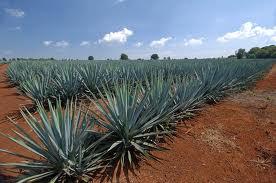When most people taste mezcal, the immediate response is “it’s smoky”, and that would certainly be correct. Some more than others, but smoky nevertheless. But as you get into mezcal, and spend more time with it, you start to find that there is a lot more subtlety and complexity beneath that smoky front. With the help of my friend Ivan Saldana, we are going to get in deeper.
As an aside, there is a saying in the mezcal world that goes…”mezcal is an acquired taste, but a taste worth acquiring.” I believe this is primarily said because of the smokiness. But interestingly, I am finding that this seems to be less and less accurate. I have introduced mezcal to MANY people, and really, it is only about 1 or 2 people out of every 10 that don’t like it on the first sip. So I don’t know if palates are changing and people have become more accustomed to unique spirits, but I increasingly find that most people like mezcal right out of the gate. 
OK Cheech, back to smoky. Ivan Saldana is an agave plant and agave distillates specialist, and also co-founder of Montelobos. He is a real Mezcal PhD, unlike yours truly. Sorry Dr., the handle is not for sale. At any rate, Ivan has recently put up a website called Anatomy of Mezcal. It is a great mezcal primer, and I particularly like the way he goes into the taste profile of mezcal. For example, in some mezcals, you may get the taste of bananas. But where does that flavor come from? The agave? The roasting process? Or what? This is what Ivan breaks down for us, and what I found to be pretty cool.
As you may know know, the taste of a mezcal is influenced by many factors from the type of agave used, to where and how it was grown, to the production process – and there is depth to each of those areas as well. So, I am going to break down each of the primary components of the flavor of a mezcal.
Most of the below is taken directly from Anatomy of Mezcal – so full credit to Ivan for bringing this to all of us (I will put all blatant plagiarism in quotes). What I like about Ivan’s piece is he talks about 4 distinct groups of flavors and where they originate in the making of a mezcal. The 4 flavor groupings are: (1) smoke, (2) cooked agave, (3) green agave (uncooked), and (4) bacterial congeneric fermentation (I told you he was a PhD). Let’s dive into each.
Smoke
“Scents and flavors come from the wood used to heat the stones in underground pits or kibas. Smoke flavors come from molecules released during combustion and are often expressed in the mezcal as notes of chili pepper, chocolate, ash, wood and fire. The higher the alcohol content is in a particular mezcal, the less intense the notes will be perceived. Variations occur in the smoke notes according to the type of wood, amount used and size of the ovens. Mezcals using steam as a cooking method do not enjoy the contribution of these notes.”
Sometimes you will hear people say that a mezcal tastes like a campfire. It might be a novice mezcal drinker who is simply unaccustomed to the smoke, or it might just be a not-so-balanced mezcal that is really smoky. But next time you sip a mezcal, think about the smoke. Are you just tasting smoke? Or is more ash? Wood? Or what? There are nuances and differences. I have tasted some mezcals where the smoke tastes more like an after-the-fact infusion than something acquired during the earthen pit roasting. So the next time you taste chili pepper, chocolate, ash, wood or fire, know that those tastes are largely derived from the roasting pit. Not all smoky taste is created equally. Appreciate the differences.
 Cooked Agave
Cooked Agave
“During the cooking process of agave piñas there are chemical reactions. Proteins are combined with sugars, releasing compounds that powerfully influence the flavor of mezcal. In typical artisanal mezcals, very slow, underground cooking will produce sweet and roasted notes like those of walnuts, peanuts, almonds, hazelnuts, cooked pumpkin, brown sugar, honey and caramel, among others.”
So whenever you taste a sweetness in mezcal it usually emanates from the cooked agave and the roasting process. Of course, the amount of sugars in a plant vary widely which is one reason why different varieties of agave, once transported to their higher calling as a mezcal, can taste completely different even if produced in exactly the same fashion. For example, I generally find tobalas, and some other wild agave mezcals, to be sweeter than espadin mezcals. So the tastes I usually get from the cooked agave are more brown sugar and honey rather than walnuts and peanuts. But that is just my palate so think about what YOU are tasting, and it might be very different.
 Green Agave
Green Agave
“Agaves are plants with extraordinary aromatic and flavor compounds, most notably the terpenes and essential oils. Approximately 30 terpenes that survive cooking have been identified in agave distillates. These plants contain fats in the cuticle and cell walls, which in alcoholic solutions such as mezcal, are converted into esters. Some notes from the raw agave include: anise, citrus, green and floral fragrances. Vanilla notes can come directly from the agave, as it is a natural compound, without any contribution of aging or wood participating as fuel in the production process. In the mouth, green notes can also impart bitter flavors characteristic of mezcal.”
So agave plants, and therefore mezcal, have terpenes. But what are terpenes? Terpenes are the primary constituents of the essential oils of many types of plants and flowers. For example, the aroma and flavor of hops, frequently used in beer of course, comes from terpenes. The terpenes present themselves in the mezcal in flavors such as anise, citrus, and floral notes. You will regularly taste these flavors in mezcal. Often, I describe a mezcal as vegetal, and for me, that is the green agave – like almost a leafy taste but young and fresh.
Bacterial Congeneric Fermentation
Now that is a mouthful.
“The fermentation process converts sugars to ethanol (common alcohol)…In most crafted mezcals, long fermentation times (up to 10 days) and the absence of added yeast causes a lot of bacteria to be actively involved in the formation of compounds impacting the sensory experience of the product…(wild yeasts) give another layer of complexity to the final product as opposed to the exclusive use of added yeast. The result is the formation of compounds with fruity notes. Some flavors and aromas typical of bacterial fermentations are banana, pineapple, ripe red and dried fruits, as well as other notes like nail polish and white gas. Fats in the mezcal can also deliver leather and animal notes.”
With mezcal, roasted agave is being fermented in open air vats using airborne yeasts. As the agave ferments, the flavor profile and aromas change (think rotting fruit) and these eventually impart certain tastes to the final product – mezcal. So if you taste bananas or pineapple in your mezcal, thank the bacteria!
Taste Test
Other than the above suggested flavors, you may find many other influences that you smell, sense, or taste in a mezcal. Among other things, the type of still which is used in the distillation process, the type of vat used in fermentation, and the storage containers for distilled mezcal can all effect the taste.
For me, the things that I most frequently get from mezcals are heat, spice, anise, roasted agave, sugar, earth, ash, floral, and vegetal (off the top of my head). But there are many more flavors to be found and you will find that you taste very different things from the person tasting right next to you.
Let’s take a look at a few of my favorites and see what I can identify in each bottle (no judgments here as I think these are all great mezcals – just hunting for flavors), and classify the findings by the four categories above.
Siete Misterios, Arroqueno
- Smoke. Gentle smoke and wood with a bit of chocolate.
- Green Agave. Not much in this category.
- Cooked Agave. Yummy brown sugar and caramel.
- Fermentation. A bit of ripe banana.
- Other. A very pleasant earthiness, perhaps form the clay pot distillation. Also, this mescal is very viscous in feel – like a buttery Chardonnay.
Ilegal Anejo.
- Smoke. Light smoke with hints of chili, heat and spiciness.
- Green Agave. Not much in this category…maybe a bit of citrus.
- Cooked Agave. Rich vanilla and caramel.
- Fermentation. Not much in this category.
- Other. Because this is aged in wood, you definitely get some of those influences which also evidence themselves in the vanilla and caramel tastes as well.
Banhez (a nod to my friend Mario who has an affection for Banhez – his tasting notes).
- Smoke. Easy wood and smoke.
- Green Agave. Not much in this category
- Cooked Agave. Lots of sweetness of roasted agave with caramel and brown sugar flavorings.
- Fermentation. Ripened banana, mango, and fruit.
Montelobos.
- Smoke. Light and gentle smoke
- Green agave. Definitely taste those terpenes coming through with some anise. Vegetal.
- Cooked Agave. Subtle sweetness with vanilla notes.
- Fermentation. Not much in this category.
All of these are fine mezcals, in fact, excellent. I am sure that you will come to different conclusions in some cases as you taste these brands, but that’s what makes it interesting and fun. Every mezcal is truly unique and while producers try to maintain the same taste profile, you will frequently find subtle differences from batch to batch of the same brand. Much as you would with bottles of wine.
So thanks to Ivan for bringing this analysis to light. This is one way to think about what you are tasting. So go on out and DRINK MEZCAL!


[…] https://mezcalphd.com/2013/09/what-does-mezcal-taste-like/ […]
Thanks for this. All posts are interesting. While I love Mezcal I could use more info. I took a friend to my favorite liquor store in Guanajuato. They have alot of different Mezcal. I was telling him about it and when we entered, the man said “mas mezcal?”. I don’t know if that was good or bad for my reputation.
I’m proud of myself for this next interaction: Last week family visited and I took them to Mercado Hidalgo in Gto centro. They were looking at decorative plates and I asked to look at a tequilero but said it was for mezcal. He handed it to me and said “cuando mal, mezcal” and I was able to finish by saying “cuando bien, tambien”. That threw him since I really am a gringa here in Central MX. He then proclaimed me Mexicana.
Gracias Maestro
Great article and will definately try a few more mezcals with this paradigm in mind. And who doesn’t like seeing their own name in print?